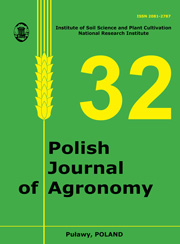DIVERSITY OF NITROGEN MANAGEMENT IN POLISH AGRICULTURE
Main Article Content
Abstract
The paper presents the issue of nitrogen fertiliser management,taking into account regional differences, in the medium--term perspective covering the years 2004–2015 (2017). Thebasis for the comparative analysis, conducted at the voivodshiplevel (NUTS-2), were data on mass statistics. The analyses showthat carrying out responsible nitrogen fertilization (in terms ofproduction efficiency and potential environmental impact) requiresmaintaining a balance between nitrogen output and input inthe agricultural production system. An unfavourable phenomenonobserved in the fertiliser management in Poland during the yearsof functioning within the European Community was an increasednitrogen consumption, within the range of 60–80 kg ha-1 AL, incomparison to other fertiliser macroelements. On the other hand,animal production in terms of natural fertilizers was a source ofapprox. 35–40 kg N gross per UA area unit. The total fertiliseruse was on average 2.9 kg N per cereal unit of the total yield,but it was strongly regionally diversified. Excessively high grossnitrogen balance and, at the same time, high fertiliser consumptionin the voivodships: wielkopolskie, kujawsko-pomorskie andłódzkie, indicate a strong environmental pressure in that area. Theopposite situation, which takes place in Małopolskie and Podkarpackie,indicates the possibility of increased mineralization oforganic matter and deterioration of soil fertility.
Article Details

This work is licensed under a Creative Commons Attribution-ShareAlike 4.0 International License.
The author grants the editorial staff of the Polish Journal of Agronomy (abbreviated as PJA) a non-exclusive and royalty-free license to use the author's copyright in the paper/printed and electronic versions of his/her work published in PJA in Poland and abroad, in whole or in any part, including placing the work in electronic databases/databases locally or available on the Internet, for an unlimited period of time in the fields of exploitation specified in article 50 of the Copyright and Related Rights Act.
Manuscripts published in Polish Journal of Agronomy are available under a Creative Commons Attribution-ShareAlike 4.0 (CC-BY-SA) license.

